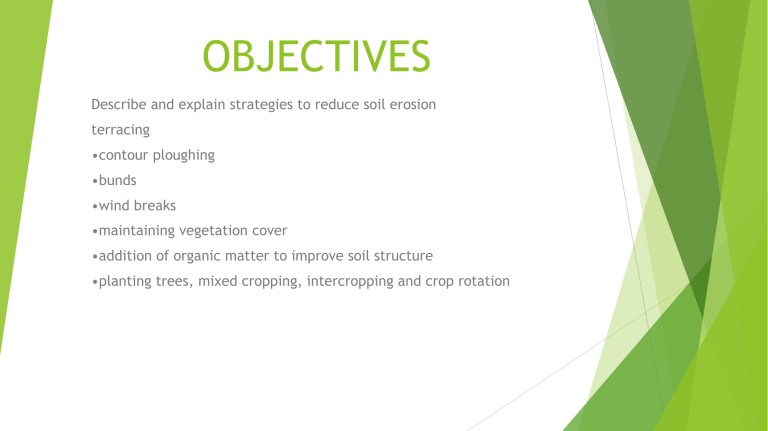
OBJECTIVES Describe and explain strategies to reduce soil erosion terracing •contour ploughing •bunds •wind breaks •maintaining vegetation cover •addition of organic matter to improve soil structure •planting trees, mixed cropping, intercropping and crop rotation 3.7. Managing soil erosion Terracing: prevents the erosion of soil by rainwater on steep slopes. In a natural slope water runs down, increasing in speedand volume, carrying soil in the run-off . In a terraced slope water is held in the flat terraced areas, causing less risk of run-off and more chance of infiltration. Often used for cultivation of rice. Contour ploughing: ploughing of land along the contourin a parallel way. Ridges and troughs (furrows) run along he contour. Each furrow holds water and prevents arge torrents of water running down the slope, preventing the ormation of gullies and run-off of opsoil. Useful for all gradients of slopes. Bunds: artificial banks at the edges of growing spaces tohold back water. Useful for crops that require moist soils e.g. rice. The water is retained on the terrace. Increases the quantity and fertility of the soil. Windbreaks: a permeable barrier used to reduce the impact of wind on an area. Without windbreaks, the soil is eroded away. Solid structures, like walls, force the wind into smaller spaces, increasing wind speed and causing eddy currents. Permeable structures, like vegetation, allow some wind to pass through, decreasing its speed and thus, the amount of wind erosion. Advantages: additional habitats for beneficial insects; roots of the windbreak prevent erosion due to run-off . Maintaining vegetation cover: Sowing legumes immediately after a crop has been harvested prevents soil erosion. It also provides more nitrogen to the soil, increasing its fertility, for the next major crop. When cultivating, the legumes can be simply ploughed No dig’ method: Existing vegetation is left until the new crop is grown. Rather than cultivating the soil, herbicides are applied to kill the weeds. Roots of the existing vegetation bind the soil until the major plant is established. Risks: herbicide residues build up. If the control of the cover vegetation is in effective, it may compete with the main crop as a weed Addition of organic matter to improve soil structure: Provides additional air gaps in the soil improves soil structure; Increases decomposers in the soil as they feed on the matter; Adds nutrients to the soil after decomposition. Acts like a sponge, holding the extra water, preventing dehydration of the soil; Reduces soil erosion as the organic matter acts like abase to smaller particles. Planting trees: Row of trees acts as windbreak; Tree canopy can provide shade for smaller plants that don’t thrive for sunlight; Provide a natural habitat for animals, that feed on pests; Tree leaves fall to the ground and add on to the organic matter. Mixed cropping: growing more than one type plant in the . same area Resources in the soil, like nutrients, are used more efficiently. Intercropping: rows of a different crop are grown between the rows of the main crop. This maximizes the use of space and other resources. Crop rotation: different crops should be grown to maintain the fertility of soil 3.8. Sustainable agriculture Describe and explain strategies for sustainable agriculture. •organic fertilizer (crop residue, manure) •managed grazing (livestock rotation) •crop rotation •use of pest resistant and drought resistant varieties of crops •trickle drip irrigation •rainwater harvesting Aims of sustainable agriculture: Meeting the needs of the population for agricultural products; Making efficient use of non-renewable resources; Supporting the natural ecosystem by following natural processes with farming techniques; Sustaining the economic independence of farmers. Organic fertilisers: Are slow acting reduces the risk of eutrophication; Are a waste product using them saves on disposal costs Are already present on many farms minimal transport costs Do not require energy for their manufacture Also improve soil structure. Managed grazing: Prevention of overgrazing; Ensure sufficient grazing; Maintaining appropriate soil fertility by animal waste; Maintaining good drainage prevents compaction of the soil.


